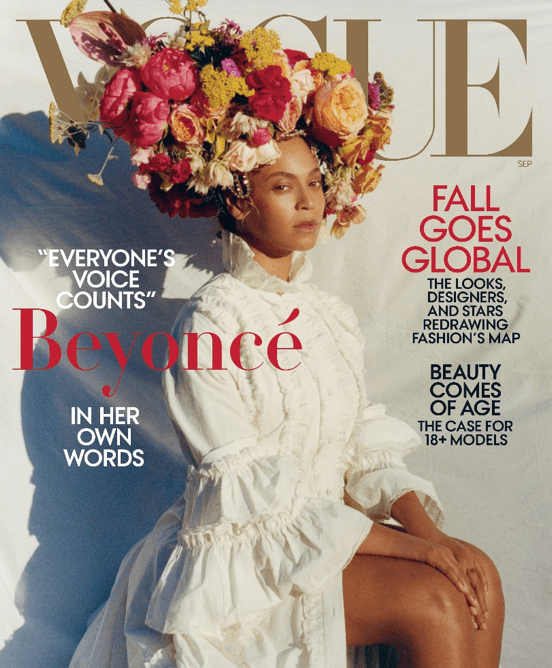
When Julie Andrews sang My Favorite Things in Roger and Hammerstein’s 1965 musical, The Sound of Music, she really wasn’t singing about things.
Well, at least not in the sense that we are used to talking about them. This was not a tune about buying or collecting “stuff.” No. This was no ode to materialism.
Instead, Andrews was singing about how the sight of certain things gave her a sense of pleasure and delight because she associated them with ideas and values that she esteemed.
Arguably, the extraordinary power of sight is what keeps the 126-year-old Vogue magazine publishing its famous September issue despite the tentative status of print culture in American society and in the world.
Background- What is the September Issue?
It’s no secret that a panoply of digital news and entertainment sites have caused print publications to struggle. Last September, The New York Times discussed the crises of the print world in an article called “The Not-So-Glossy Future of Magazines.” The Times seemed settled on the idea that print culture was fighting an inevitable decline, and it explained, “Magazines have sputtered for years, their monopoly on readers and advertising erased by Facebook, Google and more nimble online competitors.”[1]
 Two years ago, The Times mentioned some of the specific obstacles that affected Vogue’sparent company, Conde Nast. According to NYT, “Its digital business is up nearly 70 percent…but that component, as with virtually every other legacy media company, represents a much smaller percentage of overall revenue, which has declined in recent years.”[2]
Two years ago, The Times mentioned some of the specific obstacles that affected Vogue’sparent company, Conde Nast. According to NYT, “Its digital business is up nearly 70 percent…but that component, as with virtually every other legacy media company, represents a much smaller percentage of overall revenue, which has declined in recent years.”[2]
Despite these realities, Vogue still continues to print a large, ornate, and expensive commemorative edition of the magazine each September.
This yearly commemorative edition is not merely a guide for style and self-presentation. It is an attempt to provide an analysis of American culture while simultaneously making cogent assessments about important international issues.
Vogue’seditor, Anna Wintour explains: “I think we’re living, in terms of media, in a very democratic age, but I think that we still look at everything through the lens of Vogue and through our own point of view. Vogue…can help guide enormous audiences through this fascinating world.”[3]
In other words, Vogue still feels like it has something unique to offer its readers. This something is an intricately illustrated periodical that uses aesthetics as an impetus for describing, explaining, and editorializing changes in the national and international spheres.
This month’s issue celebrates global beauty and the democratization of decisions regarding what is legitimately considered a style trend. Vogue explains that the proliferation of digital media and social media sites have allowed those outside of the fashion industry and outside of the Western World to make important contributions and commentary about what is virtuous, appropriate, and/or attractive.
What is Inside this September Issue?
One of this month’s stories discusses the politics of clothing in Muslim societies and promotes a Muslim fashion exhibition at San Francisco’s de Young Museum with articles of clothing from research conducted in Indonesia and Malaysia. The article depicts the myriad ways in which Muslim women express their personal identities through their garb. It also mentions that the exhibit displays documentary photographs of women who protested the wearing of a chador, a traditional cloth worn over the head and upper body, during the 1979 Iranian Revolution.
Another story discusses dinners for refugees that are hosted by a food-event, start-up company called Komeeda. The organization sponsors “refugee-chef dinners,” that allow those who have fled from their countries to introduce their plights and their countries’ cuisines to American participants. Dinners have occurred in the Lower East side of New York, Austin, TX, and Washington D.C. Vogue reports there is a French catering company called Les Cuistots Migrateurs that has done something similar in Paris, Lyon, Madrid, and Rome.

There is also an article advocating the global initiative of raising the minimum age of working models to eighteen to combat the emotional turmoil and sexual abuse known to be pervasive in the modeling world.
The September Issue has lighter touches, as well. There are profiles of the Metropolitan Museum of Art’s new director, Max Hollein, and the man recently responsible for designing Serena’s Williams court ensembles that have been praised throughout the sports and aesthetic worlds, Virgil Abloh.
And, of course, there is an essay written by the cover star, Beyoncé, who waxes poetically about the evolution of her mind, soul, and body. She recently gave birth to twins, and like her friend Serena Williams, who also gave birth within the last year, Beyoncé experienced complications in childbirth. Both she and Williams have advocated societal acceptance of women’s bodies post childbirth.
Additionally, Beyoncé uses the pages of Vogue to express her unequivocal belief that modern communication platforms must express the voices and the struggles of those marginalized within the United States and around the world.
All of these articles are illustrated, and Vogue argues that printed illustrations are the best ways to ensure that the messages of the brand continually resonate with its readers.
Vogue’seditor, Anna Wintour puts it this way: “I think what you have to do in print is to create even more memorable images and more memorable pieces because what one consumes online or in social [media] has a much shorter shelf life, so to speak, so what print has to have is no more weight, but it has to be something that you can’t find so easily online. It has to really stand for print.”[1]
There is a desire by Wintour and her staff to appeal to their readers at a level beyond the simple transmission of rhetoric. They want their readers to remember the people, the values, the events, and the moments that they believe are notable. And with all the print and digital competition that is constantly vying for the modern consumer’s attention, it helps to have an intricately illustrated “cheat-sheet” to refer to and to collect for posterity.
Examples of Iconic Images in American Culture
In using print images to commemorate important people and moments of American culture, Vogue is continuing a tradition within America of representing and commemorating the country’s most poignant times visually. Below are a few iconic examples:

This photo was taken on September 14, 2001, three days after the historic terrorist attacks on New York and Washington. President George W. Bush flew to New York and stood at Ground Zero where the World Trade Center’s twin towers lay in ruins. Bush climbed on top of some rubble and placed his arms around one of the fire fighters, took a bull horn, and began thanking and encouraging the first responders on the scene. His famous line, “I can hear you. The rest of the world hears you! And the people who knocked down these buildings down will hear all of us soon!”[1]created a defining moment in his presidency and was a crucial step in solidifying support for the war on terror.
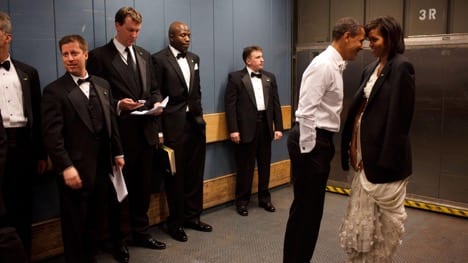
This image was taken on January 20, 2009 during the inaugural ball of President Barack Obama, the country’s first African-American president. It captures a private moment between the President and the First Lady, Michelle Obama, and contributed to the popular belief that America’s new president wasn’t just smart; he was “cool.”[1]
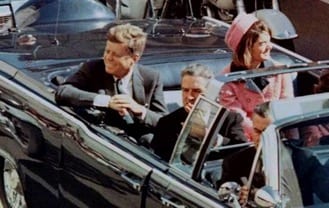
This image was taken on November 22, 1963, in Dallas, TX only a few moments before President John F. Kennedy was assassinated, which resulted in America’s loss of “Camelot.”[1]
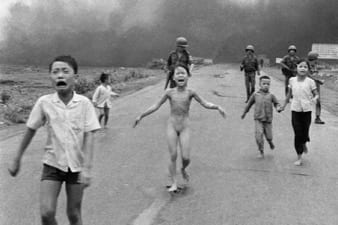
For many, this photograph of 9-year-old Phan Thi Kim Phúc, running while burned and naked in 1972 represented the horrors of U.S. involvement in the Vietnam War, despite the fact that this particular incident of horror came from a napalm bombing carried out by a South Vietnamese Air Force pilot. The photo earned a 1973 Pulitzer Prize.

This photograph reminds us that the results of an election cannot be known until every vote is counted. The prevailing wisdom of the time was that President Truman would lose the presidency to New York governor, Thomas Dewey. The day after the election, November 3, 1948, President Truman delighted in being underestimated.
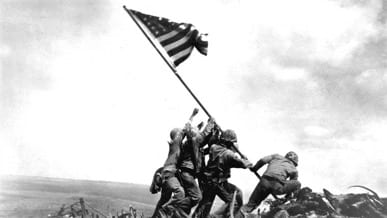
This Pulitzer Prize photo by Joe Rosenthal illustrates the raising of an American flag by five Marines and a Navy corpsman who were ordered by a commander to hoist the flag to encourage American troops and to discourage the Japanese enemy.
These images affirm that visuals are as much a part of American history as our ideas, our rhetoric, and the moments that embody, challenge, and shape us. Vogue realizes this and is continuing to contribute to our visual history. For this reason, the September issue still matters.
[1]Sydney Ember and Michael M. Grynbaum, “The Not-So-Glossy Future of Magazines.” The New York Times. September 23, 2017.
[2]Ravi Somaiya, “Conde Nast Adapts to New Forces, Leaving Some Employees Unsettled.” The New York Times. January 31, 2016.
[3]Alexandra Steigrad, “Anna Wintour on Vogue at 125 – and Defining Print in the Digital Age.” Women’s Wear Daily.September 13, 2017.
[5]Kenneth T. Walsh, “George W. Bush’s ‘Bulhorn’ Moment.” U.S. News and World Report. April 25, 2013.
[6]Julia Azari, “A Challenge for Obama’s Successor: Being a Casual, Cool President.” Politico Magazine.
[7]“JFK and the Public View,” The Kennedy Era: A CYOU project about John F. and Robert F. Kennedy. (pages.shanti.virgnia.edu) A University of Virginia site. The article sites the original publication that used the Camelot reference. Life Magazine. December 6, 1953.
[8]“Confronting the Myths of the ‘Napalm Girl.’ “ The Baltimore Sun. March 31, 2017. The article discusses the initial article that it printed about this image on June 9, 1972.
